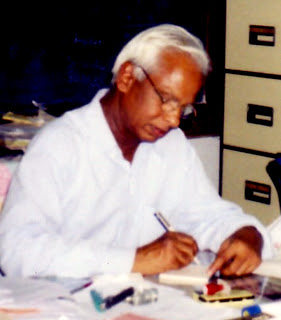In 2010, the Linguistics
department of Aligarh Muslim University had organized a really off-beat seminar
on the historical and socio-cultural aspects of culinary terms in Indian
languages and I happened to be to be there at that time and happily joined that event
there as a participant. The papers were informative and some were interesting
as well, and the discussion of these was generally good. The few papers which
dealt with the historical aspect of the terms did not really go beyond listing
of the borrowed terms and their sources, but this was nothing unusual, considering that work on words in our languages borrowed from foreign sources has so far been nothing more than this. Some papers tended to discuss foods (and the
discussion was almost always good), instead of food terms, neglecting that a
linguistic term and the object it refers to are not the same thing. Obviously
these are not directly related. For instance, there is no unicorn in the world
of nature, but it is a meaningful term of English. There is no kokua or koko
in nature but these words exist in Odia language, meaning a terrible, murderous
creature. In the villages of Odisha grandmothers still try to frighten their
grandchildren to sleep saying kokua would come if they don’t. The mind
enjoys the phrase “roll a salepuri rasagulla (the cheese based sweet
from the town called Salepur, widely known for this sweet) on the tongue”,
whereas the tongue relishes rolling the rasagulla on it.
When an object
is borrowed from a different culture, it enters the target culture with its
name, which is a linguistic object. A borrowed word embodies a fascinating cultural
and linguistic story: from which language and under what conditions it was
borrowed, how long it took to move from the periphery of acceptability to be fully
accepted by the recipient culture and the language, and what form it took when it
got nativized in both. Talking about the linguistic aspect alone, some fifty
years ago, in Odia, potato was called bilaati
aalu (potato from England) in coastal
Odisha, but now, on account of the popularity of this vegetable it is called
just aalu. Interestingly, tomato,
which is as popular, is still called bilaati
baaigana (brinjal from England) and never just baaigana. There is more to the contrast, but for the moment, let that
story remain untold. As for some similarity, both vegetables are still
excluded from the kitchen of the traditional temples, and from the discourse of naivedya (food to be offered to the
deity) and prasaada (food after the
offering) relating to these temples. Half a century ago a section of the
population of Puri in Odisha used the word ceni, with a retroflex nasal,
to refer to sugar, the word for which in the so-called “standard” Odia is cini,
where the nasal was an alveolar, not a retroflex. In the Puri variety (called “Puri
boli”) both the alveolar nasal (the consonant sound “n”) and its retroflex form
occurred then, therefore it is interesting to note that the speakers used the
non-standard form in this specific case. Similar observations apply to the
difference between the initial vowels in these two words. Facts such as these
in borrowing need an explanation, which would have a socio-cultural dimension
as well. The ceni example is a case
of borrowing from a variety of the same language - borrowing by Puri boli from
standard Odia As of now, the facts mentioned above have not even been noted in
scholarly discourse on borrowed words in Odia, which can be
said to be due to the general neglect of language varieties other than the
standard. There is very little discourse on culinary terms in our languages mainly
because words are traditionally dealt with in terms of dictionary entries, which
hardly do justice to the richness of their content. And then it
may be noted that Samuel Johnsons do not write dictionaries these days.
It is possible
that the neglect of scholarly interest by linguists (including lexicographers)
in culinary terms reflects the non-serious attitude that people often have
towards culinary discourse. Dining table talk is hardly about the dishes on the
table, and even when the dishes do figure in the conversation, it is in a manner
that is neither sincere nor serious. After enjoying a well cooked meal, one
does praise the cooking and sometimes asks for the recipe, but all this is
really politeness discourse, not culinary discourse, and as such requires no
informative answer. If the guest insists on information about the recipe, etc.,
it is sometimes seen as condescending behavior on his part and is not liked.
Well, it was
really good the linguistics department of AMU thought of organizing a seminar on the
much neglected topic of culinary terms.

No comments:
Post a Comment